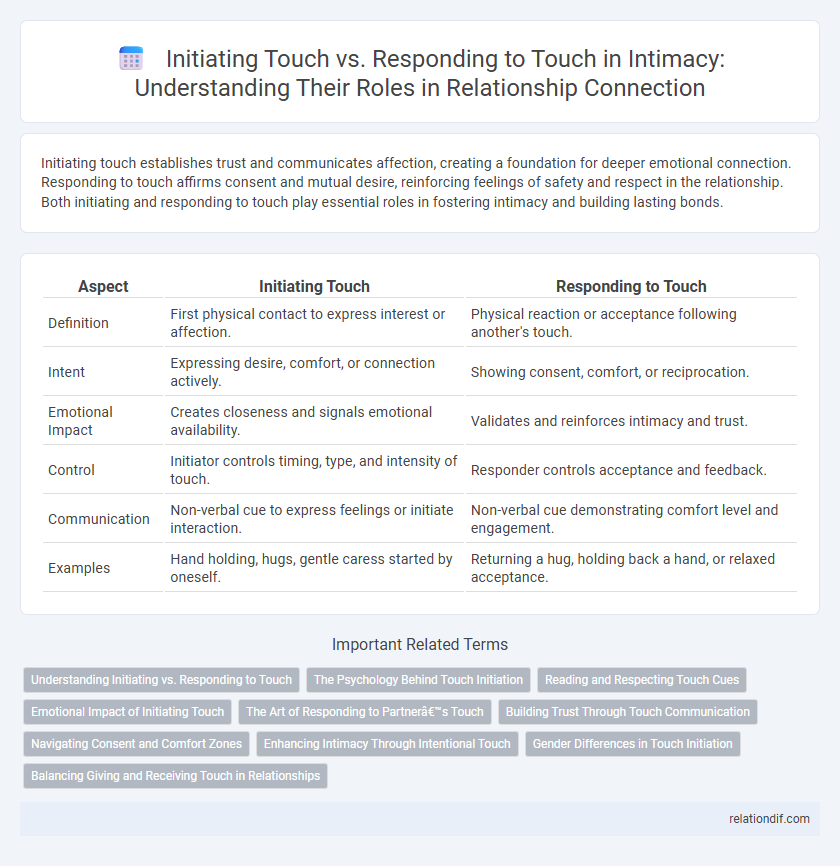Initiating touch establishes trust and communicates affection, creating a foundation for deeper emotional connection. Responding to touch affirms consent and mutual desire, reinforcing feelings of safety and respect in the relationship. Both initiating and responding to touch play essential roles in fostering intimacy and building lasting bonds.
Table of Comparison
| Aspect | Initiating Touch | Responding to Touch |
|---|---|---|
| Definition | First physical contact to express interest or affection. | Physical reaction or acceptance following another's touch. |
| Intent | Expressing desire, comfort, or connection actively. | Showing consent, comfort, or reciprocation. |
| Emotional Impact | Creates closeness and signals emotional availability. | Validates and reinforces intimacy and trust. |
| Control | Initiator controls timing, type, and intensity of touch. | Responder controls acceptance and feedback. |
| Communication | Non-verbal cue to express feelings or initiate interaction. | Non-verbal cue demonstrating comfort level and engagement. |
| Examples | Hand holding, hugs, gentle caress started by oneself. | Returning a hug, holding back a hand, or relaxed acceptance. |
Understanding Initiating vs. Responding to Touch
Initiating touch involves consciously starting physical contact to express affection, comfort, or attraction, often signaling confidence and emotional openness. Responding to touch requires interpreting the initiator's intent and reciprocating in a way that respects boundaries and fosters mutual connection. Understanding the dynamics between initiating and responding to touch enhances communication and deepens intimacy in relationships.
The Psychology Behind Touch Initiation
Initiating touch activates the brain's reward system, releasing oxytocin which fosters feelings of trust and bonding. Psychologically, initiating touch signals confidence and intention, often influencing perceived social power and emotional closeness. Responding to touch, by contrast, tends to reinforce connection through reciprocal engagement and validation of intimacy.
Reading and Respecting Touch Cues
Initiating touch requires sensitivity to the other person's comfort level and clear observation of their nonverbal responses to gauge consent. Responding to touch involves actively reading touch cues such as body language, facial expressions, and verbal feedback to ensure mutual respect and emotional safety. Prioritizing open communication and respecting boundaries enhances intimacy by fostering trust and understanding during physical connection.
Emotional Impact of Initiating Touch
Initiating touch often carries a stronger emotional impact by conveying confidence, care, and intent more clearly than responding to touch. This proactive gesture can foster feelings of security, warmth, and connection, enhancing emotional intimacy between partners. Studies in psychology highlight that people who initiate physical contact tend to build trust and deepen relational bonds more effectively.
The Art of Responding to Partner’s Touch
Responding to a partner's touch with mindful awareness enhances emotional connection and deepens intimacy by validating their gesture. Sensitivity to the type, location, and timing of touch encourages a harmonious exchange, fostering trust and comfort. Mastering the art of receptive touch communication strengthens relationship bonds and encourages mutual vulnerability.
Building Trust Through Touch Communication
Initiating touch plays a crucial role in building trust by signaling openness and vulnerability, encouraging emotional connection. Responding to touch with sensitivity and attentiveness reinforces safety and mutual respect, deepening intimacy. Consistent, positive touch communication fosters a secure environment where trust can grow organically between partners.
Navigating Consent and Comfort Zones
Initiating touch requires clear, enthusiastic consent to respect personal boundaries and ensure mutual comfort. Responding to touch involves attentive awareness of verbal and nonverbal cues, allowing for fluid adjustment based on the other person's comfort level. Navigating consent and comfort zones fosters trust and emotional safety, establishing a foundation for healthy intimate interactions.
Enhancing Intimacy Through Intentional Touch
Intentional touch initiates a deeper emotional connection by conveying care and presence, while responding to touch reinforces mutual trust and comfort in intimacy. Research indicates that deliberate physical contact activates oxytocin release, enhancing bonding and attachment between partners. Prioritizing mindful touch over automatic reactions strengthens relational closeness and emotional resonance in intimate relationships.
Gender Differences in Touch Initiation
Gender differences in touch initiation reveal that women are more likely to initiate affectionate touch in social and intimate settings, often using touch to express warmth and empathy. Men typically respond to touch rather than initiate it, with their touch behaviors more linked to dominance or control in certain contexts. These patterns highlight underlying social norms and gender roles that shape how individuals use touch to communicate intimacy and connection.
Balancing Giving and Receiving Touch in Relationships
Balancing giving and receiving touch in relationships enhances emotional connection and deepens intimacy by fostering mutual trust and comfort. Initiating touch communicates care and affection proactively, while responding to touch affirms attentiveness and emotional receptivity, creating a dynamic interplay of physical communication. Maintaining this equilibrium supports healthy boundaries and promotes a reciprocal flow of affection that strengthens relational bonds.
Initiating touch vs responding to touch Infographic

 relationdif.com
relationdif.com